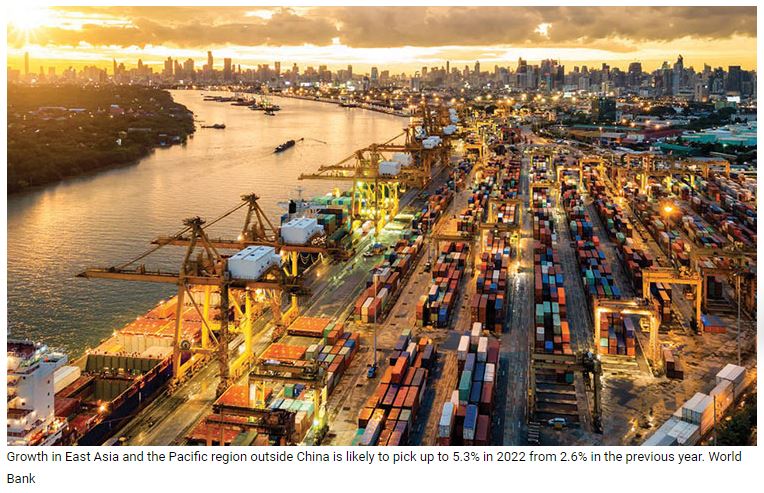East Asia & Pacific region may sustain growth; risks linger: World Bank
The World Bank has painted a rosy picture for East Asia and the Pacific region excluding China for this year. The growth in the region outside China is likely to pick up to 5.3 percent in 2022 from 2.6 percent in the previous year, says the East Asia and Pacific October 2022 Economic Update of the World Bank, released in Washington on Monday.
“Economic recovery is underway in most countries of East Asia and the Pacific,” said World Bank East Asia and Pacific Vice-President Manuela V. Ferro.
While most developing East Asia and the Pacific countries have bounced back this year after hitting a marked low due to the Covid-19 pandemic, the Chinese economy continues to be affected by the steps taken to contain the spread of the deadly virus, which devastated the global economy after its reported eruption at the fag-end of 2019.
However, in a note of caution, the World Bank has also stated that the economic performance across the region could be compromised by slowing global demand, rising debt, and a dependence on short-term economic measures to cushion against food and fuel price increases.
As East Asia and the Pacific region nations were readying for slowing global growth, they “should address domestic policy distortions that are an impediment to longer-term development,” the World Bank official said.
China, the second-largest global economy after the USA, which previously led from the front in the economic recovery in the region, is projected to grow by 2.8 percent in 2022, which is a sharp decline from 8.1 percent growth reported for 2021.
China, which accounts for around 86 percent of the region’s output, has been taking targeted public health measures to contain outbreaks of the coronavirus disease. But these steps have also been inhibiting economic activity, leading to slower growth compared to previous years.
However, the World Bank report says the overall growth of the region may slow to 3.2 percent this year from 7.2 percent reported in the previous year. But it is expected to accelerate to 4.6 percent in 2023, the report adds.
According to the Update, growth in most of East Asia and the Pacific has been driven by a recovery in domestic demand, following the easing of the Covid-related restrictions, and growth in exports.
The report says the global economic slowdown is beginning to dampen demand for the region’s exports of commodities and manufactured goods. Rising inflation abroad has provoked interest rate hikes, which in turn have caused capital outflows and currency depreciations in some East Asia and Pacific countries.
These developments, says the World Bank, have increased the burden of servicing debt and shrunk fiscal space, hurting countries that entered the pandemic with a high debt burden.
As countries of the region seek to shield households and companies from higher food and energy prices, current policy measures provide much-needed relief, but add to existing policy distortions. Controls on food prices and energy subsidies benefit the wealthy and draw government spending away from infrastructure, health and education.
Lingering regulatory forbearance, aimed to ease lending through the pandemic, can trap resources
in failing companies/organisations and divert capital from the most dynamic sectors or businesses, the report points out.
“Policymakers face a tough tradeoff between tackling inflation and supporting economic recovery,” said World Bank East Asia and Pacific Chief Economist Aaditya Mattoo.
“Controls and subsidies muddy price signals and hurt productivity. Better policies for food, fuel, and finance would spur growth and insure against inflation,” Mattoo remarked.
Source: https://www.khmertimeskh.com/501158892/east-asia-risks-linger-world-bank/


 English
English




